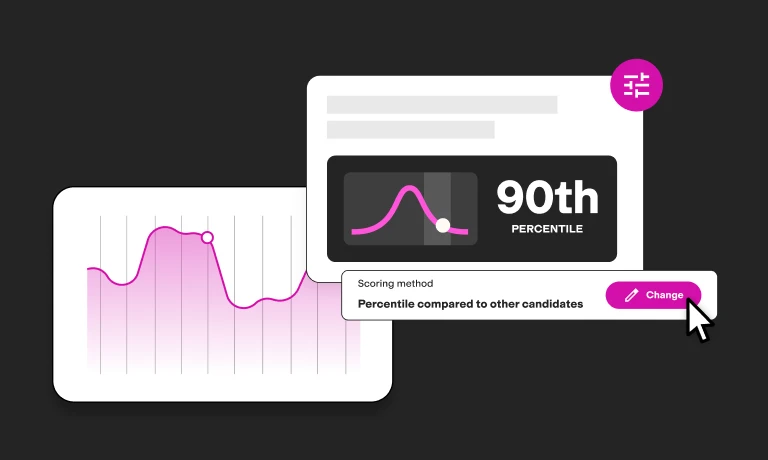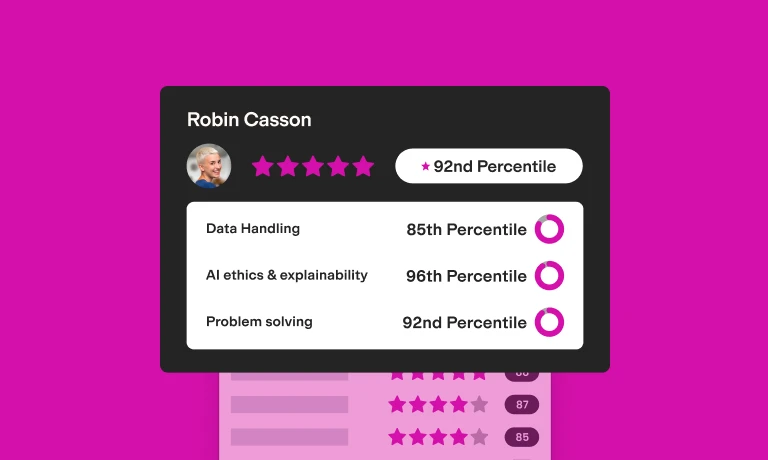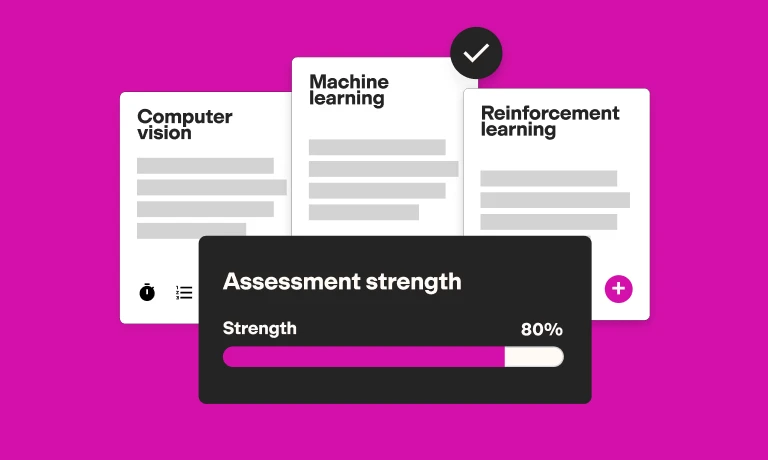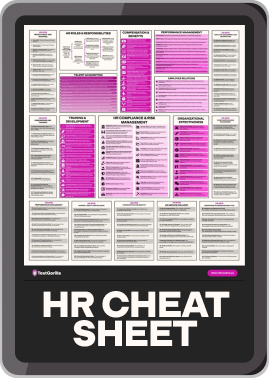The structure of a team determines how well employees work together.
Building a strong team requires you to organize roles to promote better communication and productivity, enabling your employees to express their ideas in a collaborative workplace and meet organizational goals.
However, it’s not always obvious what team structure works best. You may need help figuring out where to start when organizing teams’ structures in your company if you’re in a role that requires strong cultural add skills, like a leadership position.
Keep reading our comprehensive guide for the best advice on how to build a winning team.
Table of contents
What is team organizational structure?
A team structure in an organization is a professional framework that defines key responsibilities, leadership, and relationships between employees and how they contribute to the overall goal of a company. Your chosen structure can change how employees collaborate and complete tasks for your business’s projects.
Team structures are there to help processes run smoothly. For example, in a product-focused team organizational structure, teams are organized around different product lines to ensure clarity of purpose.
The top 9 team organizational structures
Before we cover how to establish a team that can meet and exceed its goals, let’s discuss the different types of organizational structures.
The 9 most common team structures: Summary table
Here’s a quick overview of the most common team organization options for how to build a high-performing team.
9 ways of organizing teams | Best for |
1. Hierarchical structure | - Large corporations - Companies with multiple business lines or departments - Creating clear paths for progression |
2. Functional structure | - Large corporations that continuously produce products or services - Organizations with stable and predictable processes |
3. Matrix structure | - Changing and complex environments like tech - Organizations where collaboration is critical - Communication and professional development |
4. Process-based structure | - B2C organizations where customer service is critical - Technical industries where process optimization is necessary |
5. Circular structure | - Revamping team structure in traditional industries - Companies where cross-departmental collaboration is helpful |
6. Flat structure | - SMEs that emphasize collaboration - Creative organizations that take a skills-based approach to projects |
7. Network structure | - Fully-remote companies - Working with numerous external vendors |
8. Product- or market-focused structure | - Large corporations with highly specialized product lines, particularly in manufacturing -Corporations with lines in different markets |
9. Geographical structure | - International organizations that operate across cultures |
1. Hierarchical structure
The hierarchical team structure is a type of team structure that includes many other team structures listed below.
Hierarchical teams and organizations include a vertical “chain of command” or flow of information with different levels of authority that usually follow this pattern:
Chief executive officer
Senior leadership team, for example, head of finance and head of people
Senior manager
Assistant or middle manager
Team leader
Staff or lower-level employees
It is common for companies to design team structures and org charts this way because:
Decision-making processes are clear because of the delegation of authority
Roles and responsibilities are clear
Paths to promotion are straightforward
It promotes departmental loyalty
It’s easy to grow
Success with a hierarchical team structure relies heavily on choosing the right people to promote up the hierarchy into decision-making roles. Use talent assessments during hiring to get the best results with this team based organizational structure.
For example, you can use a Leadership and People Management test to identify candidates for promotion up the ladder.
To learn more about skills-based hiring, book a demo with TestGorilla today.
Best for:
Large corporations
Companies with multiple separate business lines or different departments
Creating clear career paths for progression
2. Functional organizational structure
A functional team structure is another example of the hierarchical team organizational structure, with the additional element that departments are organized based on skill areas such as:
Sales and marketing
Human resources
Product development
Finance and accounting
The heads of the departments comprise the senior leadership team, and each one manages another hierarchical team structure, dictating tasks within their own department.
Studies show that most companies use this team based management structure, likely owing to its high productivity levels and low operation costs.
Best for:
Large corporations that produce products or services continuously
Organizations with stable and predictable processes that are unlikely to change over time
3. Matrix structure
The matrix team structure is another hierarchical team organizational structure, but instead of a vertical (top-down) reporting structure, there are multiple reporting relationships that shape the work environment.
In addition to having functional departments like development teams, there are also cross-functional teams dedicated to certain projects. Here’s an example of team structure in the matrix configuration:
| Head of development | Head of marketing | Head of data |
Team lead 1: High-level projects | Senior developer | Senior marketer | Senior data analyst |
Team lead 2: Mid-level projects | Junior developer | Social media | Junior data analyst |
Best for:
Changing and complex environments like tech
Organizations where collaboration is critical
Promoting communication and professional development
4. Process-based structure
You guessed it. It’s another hierarchical team structure.
This time, leaders design team structure around cross-functional teams instead of basing team organization on job functions (such as development, sales, or marketing).
Chief executive officer | ||
Head of research and development | Head of customer acquisition | Head of supply chain |
Scientist Project manager Market analyst | Sales rep Account executive Customer success manager | Demand planner Operations manager Logistics manager |
Best for:
B2C organizations where customer service is critical
Technical industries where process optimization is necessary
5. Circular structure
Let’s be honest. There’s not much difference between a circular team structure and your standard hierarchical team organization.
The main difference is that, instead of presenting a top-down view of authority in the organizational chart, a circular team structure presents all departments as interconnected and surrounding or supporting central leadership.
If you can pull it off, a circular team organization can create a positive company culture, which is important to 86% of job seekers.
Do this by hiring for collaboration and communication skills using skills testing. Our Communication test and personality tests can evaluate a candidate’s:
Language fluency
Personality type
Collaboration style
Best for:
Organizations in traditional industries that want to break out of old-fashioned structures
Companies where cross-departmental collaboration is helpful, though not integral
Create collaborative teams with TestGorilla
Want to explore how TestGorilla's tests can help you create collaborative teams?
6. Flat structure
The flat organizational model is the most radical departure from this list’s traditional team based structure. When the structure of the team is flat, there are few levels to the organization. This structure is unlike hierarchical organizations that may have seven or more different tiers.
An example of establishing a team this way comes from Morning Star, a tomato processor, where no one has a job title except the president.
This structure of teams relies heavily on collaboration, preventing the silos and talent hoarding that can occur in functional and process-based team structures.
Best for:
Small to medium organizations that emphasize collaboration
Creative organizations that take a skills-based approach to projects
7. Network structure
The network team structure is another non-hierarchical organizational model that describes numerous multidisciplinary teams working independently to achieve common goals.
These teams can include:
Remote IT teams
Design teams
Editorial teams
This team organizational structure is highly flexible and collaborative and lends itself to remote and digital work.
Best for:
Fully-remote and distributed companies
Small businesses
Companies that work with numerous external vendors, such as freelancers, consultants, or business partners
8. Product- or market-focused structure
Product- and market-based team structures are similar to functional and process-based methods of organizing teams.
The product-based example of team structure separates teams based on the product line they work on. It is common in manufacturing companies like Ford.
Consumer goods companies with products spread across different markets, such as home goods, clothing, and food, often use market-based team structures.
Best for
Large corporations with highly specialized product lines, particularly in manufacturing
Corporations with lines in different markets that require a different marketing approach, such as consumer goods
9. Geographical structure
Finally, geographical team structures are similar to market-based team structures. Organizations with outposts in different regions that require context-specific governance use them. They include:
Supermarkets and large retailers
International education organizations
Media companies
An advantage of this team organizational structure is that it helps navigate cultural differences.
For example, Japanese managers emphasize hierarchy more in management, whereas American workers may be more open to a circular structure.
Letting each geographical base decide the structure of teams enables the latter to problem-solve in a way that feels natural and reduces the likelihood of creating dysfunctional teams.
Best for
International organizations that operate across cultures
The best insights on HR and recruitment, delivered to your inbox.
Biweekly updates. No spam. Unsubscribe any time.
The benefits of organizing workers into efficient teams
We all know the risks of bad team structure: 18% of startups fail owing to team problems.
But what about the benefits of organizing workers into efficient teams? Here are the top five.
Benefits of strong team structures | Summary |
Stronger communication | - By aligning your team structure with your organizational goals, you create smoother workflows - Using skills tests to hire candidates who work well in your team structure improves collaboration |
Better problem-solving | - Clearly defining roles and responsibilities gives employees ownership over their work and empowers them to solve problems themselves - Choosing a collaborative team structure prevents silos and encourages employees to seek support from expert colleagues |
Increased engagement, productivity, and retention | - Having ownership over their work and collaborative relationships with their colleagues keeps employees engaged - Increasing engagement could reduce turnover by as much as 43% |
Positive company culture | - Lower turnover reduces business disruption and stress within teams - Increasing healthy collaboration and open communication within and between teams fosters a friendly organizational culture |
Elevated bottom line | - Higher retention rates reduce expenditure on hiring and medical insurance outlays for burnout and stress - Productive collaboration leads to greater innovation and organizational agility - Stronger productivity leads to boosts in revenue |
3 examples of team structures
It can sometimes be tricky to tell a company’s team organizational structure from the outside. Google any structure in this list, and someone has made the case for Apple following that team structure.
So, we conducted research to find three examples of different, successful team structures.
1. Philips’ matrix team structure
An example of matrix team structure in action comes from Philips, which implemented this model of organizing teams in 1970. Company managers reported to not only product heads but also geographical managers.
The outcome was so successful that other organizations, including Hughes Aircraft, adopted the same team structure.
2. Adobe’s functional team structure
Adobe’s team based organizational structure uses two functions. Digital media teams help organizations create, publish, promote, and profit from their content. Digital experience teams support customer experience management.
Adobe also has departments for the Adobe Creative Cloud product line and functions such as employee experience, finance, and legal.
3. IBM’s product-focused team structure
Like many organizations, IBM’s team based organizational structure uses several of the team structures shown above.
However, the governing team organization method used is a product-focused team structure based on specialization, with the company’s teams falling into four key product-type sections:
Software
Consulting
Infrastructure
Financing
These departments have subcategories – function-based and geographic-based departments and divisions.
How do you build a team? 5 tips for team organization
Here are five tips to help you create the best team structure for your organization.
1. Create achievable goals
Team members must have clear and attainable goals that relate to the organization’s mission to ensure the goals motivate managers and employees.
Arranging in-person meetings to discuss their targets, key team performance indicators, and how they can achieve them as a collaborative team is a must.
Before creating your company’s goals, think about the following questions:
What motivates the team?
How can they earn rewards?
What are the short- and long-term goals?
Can you use SMART goals to define a mission?
Can employees adjust their goals?
Are they achievable?
2. Define company expectations
Employees should be aware of expectations when working together. This awareness prevents confusion and arguments over designated tasks.
You can make expectations clear by hosting meetings with the whole team and one-on-one and answering questions from team members and stakeholders.
3. Focus on a positive work culture
Employees lack the motivation and inspiration to focus on teamwork without a positive workplace culture. Maintaining clear and consistent expectations could also help employees meet company requirements.
Other ways to reinforce a positive work culture include:
Promoting diversity in the workplace
Giving frequent feedback
Creating a sense of purpose
Praising people when necessary
Arranging fun events
Providing training
4. Leave room for professional development
Employees need to develop skill sets to progress and excel in their careers. You can design professional development plans before making the team structure, ensuring each employee can build on their existing skills to innovate in their current role and access promotions.
5. Engage with all team members
You should never exclude someone from a team structure. It’s important that all employees feel equal when it comes to team building.
Consider arranging individual meetings to determine how each employee performs in the team. Alternatively, you could implement frequent, informal feedback check-ins with each employee.
You must take ego out of the equation. When you spot that an employee has missed a target, use it as an opportunity for upskilling rather than criticism, and remind them that whether they succeed or fail, they do it as a team.
What to remember when creating your winning team structure
In this blog post, we’ve outlined the benefits of organizing workers into efficient teams and which team structures you should consider, and we’ve also given examples of team structure in real businesses.
The message is clear: Creating a team structure requires time and planning. Before setting clear tasks, you should carefully evaluate each employee’s skills, personality, and knowledge.
The best way to do this is with a skills-based hiring approach. Take a tour to see what this looks like, or book a demo today to learn more about the best skills to create a winning team structure.
You can also sign up for our free forever plan to experiment first-hand with how skills-based hiring could work in your business.
Team structure FAQs
Do you need quick answers to big questions about team organization? Here are some commonly asked questions about organizing teams.
What are team structure and dynamics?
Team organizational structure is how teams are organized internally – for example, having one manager and several team members with clearly defined roles and responsibilities – and within the larger organization. The benefits of organizing workers into efficient teams include the dynamics that you can produce by choosing different team structures. For example, a matrix team structure encourages interdisciplinary collaboration.
What is the core team structure?
The “core team” is a group composed of individuals who are subject matter experts in the different functional areas of an organization. Their role is to consult on important projects and ensure cross-departmental efficiency.
What is the structure of team design?
The structure of team design depends on factors like your industry, goals, and culture, and there are many ways to build a team based organizational structure to suit these needs. Most organizations opt for a hierarchical team structure, in which authority ascends vertically from junior staff through different levels up to a few select leaders, usually topped by the chief executive officer.
What is the most effective team structure?
The hierarchical organization structure is often the most effective team structure because authority is delineated, which makes decision-making highly efficient. However, the most effective method of organizing teams depends on your organization’s goals, and there may be another team based structure that works better for you.
Scroll up to the heading titled “The top 9 team organizational structures” to find out more.
How do you divide work in a team?
To divide work in a team, identify all the tasks that need to be completed and assign them to your team members based on their function, position, and skills. This division happens in most team structures, such as hierarchical teams. However, this may differ in other team organizations. One example is a flat team structure, where determining roles and responsibilities is a collaborative effort among team members.
You've scrolled this far
Why not try TestGorilla for free, and see what happens when you put skills first.



















